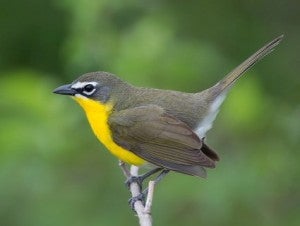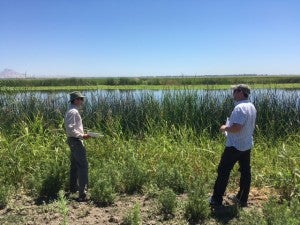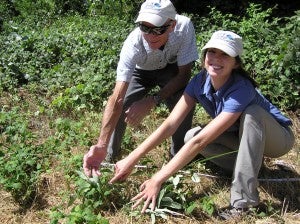
A pair of Swainson’s hawk nest in a 100-year-old valley oak tree at Davis Ranch in Colusa, California. (Credit: Emily James)
The Golden State is well known for its robust and diverse agricultural output, even during times of drought. In 2014, California’s farms, ranches and nurseries turned out $54 billion worth of everything from oranges to rice, and milk to nuts.
Our farms and ranches are less renowned for the rich wildlife habitat they also provide, in some cases for threatened species like the Swainson’s hawk and giant garter snake, which have long struggled with the disappearance of their historic habitat in open grasslands and tule marshes.
The Swainson’s hawk population in California used to be close to 17,000 mating pairs. Today, that number is closer to 2,000. And the giant garter snake has faced the loss of 95 percent of its historic Central Valley wetland habitat. In both cases, landscape conversion and fragmentation, in addition to land management practices such as rodent control, have steadily worn away the suitable habitat for these species.
Fortunately, many species are adapting to these landscape changes and, with wildlife-friendly practices, are able to thrive on productive California farms and ranches. Farms like Davis Ranch.

Restoration along the part of the property abutting the Sacramento River is sure to pay big dividends for birds like the yellow-breasted chat as the forest matures.
Wildlife-friendly farming
Spanning thousands of acres, Davis Ranch has rice fields as far as the eye can see. It also produces tomatoes, walnuts and other crops. But the family owners have invested in more than just their crops. They are committed to farming in a way that contributes to the sustainability of both the local economy and environment.
Davis Ranch has been home to several pairs of Swainson’s hawk for more than a decade, providing the birds with plentiful foraging opportunities by establishing hedgerows adjacent to rows of crops to create prey habitat, and preserving an ample supply of nesting trees around its fields.
During a recent visit to Davis Ranch, I was pleased to see that these efforts have also paid off for several other riparian bird species. On the clear blue day, you could see and hear birds in every corner of the expansive property.

Brian Halstead (left), a wildlife biologist from the U.S. Geological Survey, points out various habitat attributes for giant garter snake at Davis Ranch.
I also saw a lot of prime giant garter snake habitat around the farm – not surprisingly, as U.S. Geological Survey scientists have been working in close cooperation with the landowners to monitor a robust snake population on and around Davis Ranch for over a decade. The farm has factored the snake into its farming practices by preserving vegetation along and within the ranch’s waterways to provide cover from the snake’s predators.
Finally, I was pleasantly surprised to encounter a number of monarch butterflies fluttering about the property, which gave us an opportunity to discuss the conservation potential of managing for the monarch’s milkweed habitat at Davis Ranch as well.
Maximizing for crops and conservation
On my recent visit to Davis Ranch, I was joined by many colleagues and partners who have been working with me over the past several years to develop the Central Valley Habitat Exchange – an emerging conservation program that strives to create a future where landowners are compensated for sustainable management practices, like those on Davis Ranch.

My EDF colleagues found a monarch caterpillar while counting milkweed stems at Davis Ranch. Read more about their work to develop a habitat quantification tool for monarchs here.
Before farmers and ranchers can get paid for conserving and restoring habitat, we need to make sure that we are accurately measuring the habitat improvements. Our science team is now in the process of finalizing a habitat quantification tool that will do just that, giving us the ability to assign credit values to certain activities and direct payments to deliver the most conservation per dollar invested.
While the presence of birds, snakes and butterflies on Davis Ranch is already proof that it is ably supporting them, the habitat quantification tool will offer insight as to whether other management practices could help even more. The hope is that this tool will ultimately be used to maximize the habitat outcomes of private lands throughout the Central Valley, putting California’s farms and ranches to work for wildlife.









